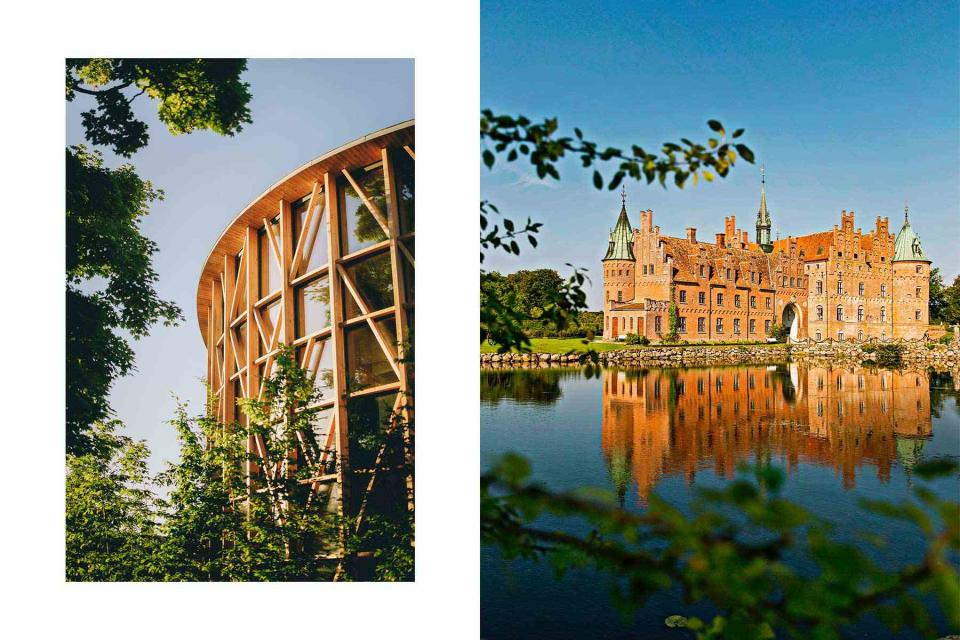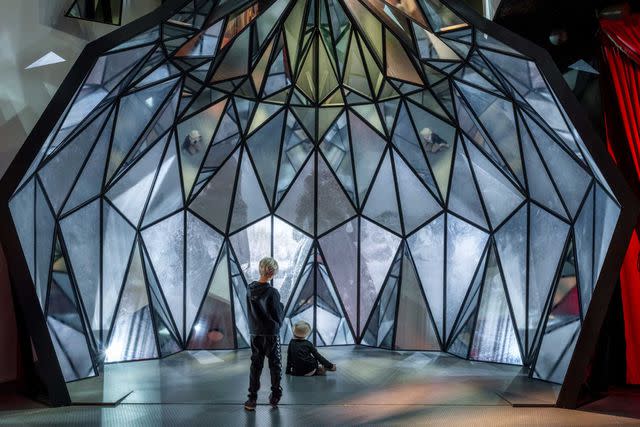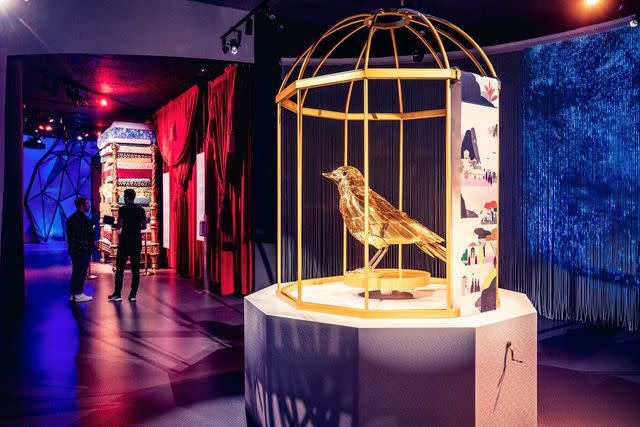This App Took Me on a Fairy-tale Trip Through Denmark With Stops at a 13th-century Castle, Picturesque Towns, and a New Museum
These are the places that inspired Hans Christian Andersen’s magical tales — from castles to cobblestoned streets to a new interactive museum in the writer’s hometown.

From left: DANIEL JENSEN/COURTESY OF VISIT ODENSE; GULLIVER THEIS/IMAGE PROFESSIONALS GMBH/ALAMY
From left: The exterior of H.C. Andersen’s House museum; Egeskov Castle, in Kværndrup, Denmark.From his room at the top of Gisselfeld Kloster, Hans Christian Andersen looked out at the pillowy green Danish countryside, with its chestnut and poplar trees dotting the fields leading off toward the horizon. Below his window, he could see the mirror-like moat, which contained a little knot of squabbling ducks. It was here, one July afternoon in 1842, that inspiration struck the writer, and “The Ugly Duckling” was born.
Andersen — who was nicknamed “The Perfect Wizard” by one of his contemporaries for the way he could weave a tale — achieved fame in the mid 19th century by publishing around 160 fairy tales, many of which went on to become deeply embedded in Western culture, including “The Little Mermaid,” “The Emperor’s New Clothes,” “The Snow Queen,” and, of course, “The Ugly Duckling.” Born in Odense, on the island of Funen, to a shoemaker and a washerwoman, Andersen grew into a literary giant who regularly mingled with members of Danish high society.
To preserve his legacy, H.C. Andersen’s House, a $54 million museum that celebrates his life and work, has opened in Odense. Designed by Kengo Kuma & Associates, the superstar architectural firm behind Tokyo’s Olympic Stadium and Copenhagen’s forthcoming aquatic center, the museum is in the heart of old town, set between half-timbered houses and tight, seemingly miniature cobblestoned streets. As I descended a curving ramp into the museum’s interior, I had the sense of stepping into one of Andersen’s stories. Inside, the writer’s life is chronicled through his photographs, drawings, and personal effects, including a series of heartfelt letters he wrote to friends throughout his life.

RASMUS HORTSHØJ - COAST/COURTESY OF H.C. ANDERSEN’S HUS
H.C. Andersen’s House museum exhibits include the Snow Queen’s mirror.The exhibits tell the story of Andersen’s life in a whimsical way. On display are objects — like his famous stovepipe hat, size 14 boots, and beloved pen — some of which come to life in the audio tour. (The English script was written by Daniel Handler, a.k.a. Lemony Snicket.) Of course, there are tributes to Andersen’s most famous works, too. One exhibit is composed of 20 multicolored mattresses piled high, in an ode to “The Princess and the Pea”; another shows a representation of reflections in the Snow Queen’s mirror. There is also an extraordinary subterranean room where visitors can gaze up through a water basin to the sky, recalling the Little Mermaid’s yearning to be a part of the world above.
A satellite to the main museum is the H.C. Andersen Childhood Home, set in the half-timbered yellow house where the writer grew up. Its rooms have been decorated to match the descriptions in his autobiography, showing how poor the family was.
Throughout his life, Andersen was a perennial traveler, a self-described “bird of passage.” While the museum is a superb introduction to his work, I wanted to understand how he lived. To do that, I had to head into the part of the Danish countryside that was both his home and his inspiration. Using the Hans Christian Andersen Trail App, travelers can see a network of places in the region the writer visited during his life and chart a course between the grand estates and mansions of southern Denmark. There, he would write new stories by day and tell old favorites around the fire by night. The islands in the area have more than 100 castles and stately homes, about 20 of which can be booked for overnight stays. Among the standouts is the 13th-century Broholm Castle, where Anderson was said to indulge in wine during dinners before sleeping in one of the building’s romantic bedrooms. (During my stay, I regret to report, I found no pea under my mattress.) The trail also features places where the scenic landscape would inspire other stories, including gardens, such as Sanderumgaard on Funen, and house museums, like Egeskov, a well preserved Renaissance castle surrounded by water.

JONAS LEGARTH/COURTESY OF VISIT ODENSE
Artists’ interpretations of scenes from stories like “The Nightingale” and “The Princess and the Pea” at H.C. Andersen’s House museum.But Gisselfeld, where the Ugly Duckling swam into being on that July afternoon, has to be the finest of them all. Andersen stayed on the lower floors of the castle (he was terrified of being trapped by fire, and traveled with a length of rope in his bag if he needed to escape), but he would write on the top floor. Today, visitors can book a room at a delightful B&B in the old gardener’s quarters called Paradehuset and dine in the large orangerie.
Andersen’s story ends in Copenhagen, where he spent his later life and was ultimately buried. His mark is everywhere, from the statues of his characters sprinkled liberally around the city — there are multiple “Little Mermaids” — to the namesake suite at his favorite hotel, d’Angleterre.
Dejligt — a Danish term that translates beyond the English delight to an intangible blend of charm and beauty — was Andersen’s favorite word. The great storyteller created a world for himself and his readers that was full of it. Two hundred years later, that world is still waiting to be discovered — whether in the pages of his books or in the castles, towns, and landscapes that gave them life.
A version of this story first appeared in the December 2022/January 2023 issue of Travel + Leisure under the headline "Happily Ever After."
For more Travel & Leisure news, make sure to sign up for our newsletter!
Read the original article on Travel & Leisure.


